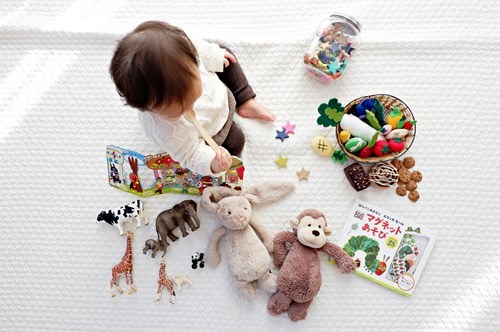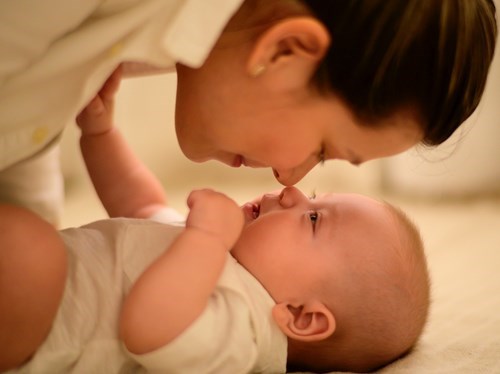Babies Eyesight After Birth
17 March 2020

Eyes develop well enough to perceive light, shapes and some colour, before birth.
Did you know? That although the eyes develop before birth, a new-born baby can only see around eight inches away. Visual development often takes a year to fully mature; although all babies develop at different stages.
Here’s a little glimpse into eye development before birth…
The actual structures of the eyes begin to form around the 6 week mark of pregnancy. But it’s during week 7, when the baby is the size of a blueberry, that the vital parts of the eye (cornea, iris, pupil, lens, and retina) start to appear.
Fast-forward 20 weeks and the baby’s eyes can now open! In fact the baby will be able to blink in response to light, because the retinas are now in full working order. Some expectant mothers shine a light at their stomach and wait for the flutters of movement.

Want to learn about the major visual milestones after birth? Keep reading…
Birth – four months
At birth, a baby's eyes have the visual acuity of 20/400
It will probably come to no surprise that babies are not born with fully functioning visual systems. Shapes, light and movement is about all a new-born can make out.
The little vision that they do have is very hazy. For the first four months of life primary focus is only 8 inches away; with anything more than 20cm away seen as a complete blur.
Not only this, but new-borns can only see through their peripheral (side) vision because central vision is yet to evolve.
Five – eight months
During these months colour perception should be kicking in. Your baby should now be able to see all the colours of the rainbow; meaning that they are probably also beginning to show more of an interest in colourful toys and pictures.
Eight months after birth, babies often start to copy facial expressions. Have some fun and see what faces you can get your baby to make!
A big moment for every parent is when they see their baby crawl for the first time; which generally happens during these months. Interestingly, many experts advise new parents to encourage crawling rather than early walking because it aids eye-hand coordination.
Nine months – one year
This is an exciting stage, when the little one will start to pull themselves up to stand. They can generally judge distance very well by now and grasp objects between their thumb and forefinger. Because of this babies will now be able to throw things with more precision- meaning more toys flying through the air and hitting you on the head!
Somehow it’s almost impossible to resist the urge to play peek-a-boo when around a baby of this age and there’s a good reason why you should be. As well as tickling your funny bone, this classic baby game helps to stimulate the senses, build motor skills and strengthen visual tracking.
One – two years
By one or two years of age, eye-hand coordination and depth perception should be well developed; with visual systems pretty much on par with an adult.
Due to this new and exciting view of the world, you’ll notice that around this age babies become fascinated by everything around them; constantly exploring their environment. This is the perfect time to childproof just about every cupboard and drawer in the house.
Recognition of familiar objects and pictures should also be fully developed by now; reading a pictorial storybook every night becomes very beneficial at this stage.
Finally, although a nightmare for some parents, most babies will have also discovered that they can now use their motor skills to scribble with a crayon. With the uncontrollable allure between crayons and the wall, this is probably a good time to stock up on paint!
Common vision problems in infants

Amblyopia (lazy eye)
Amblyopia, commonly known as lazy eye, is a condition where vision in one or both eyes does not develop correctly. This occurs because the eye and the brain are not working together properly.
Usually only one eye is affected by amblyopia, as a result of the brain favouring the stronger eye. If ignored, over time, the brain will learn to completely disregard the images sent from the lazy eye- causing the problem to worsen as a result.
Amblyopia is a leading cause of vision loss in kids, affecting around three out of every 100 children.
Luckily, there are treatment options available. In order to treat amblyopia, the brain needs to learn to pay attention to images being transmitted by the lazy eye- ultimately strengthening its vision. This can be achieved through the use of glasses, eye patches, eye drops or as a last resort, surgery.
Blocked tear ducts
One in five babies is born with a blocked tear duct. This is not harmful and won’t disrupt visual development; in most cases the condition clears up by itself in a year or two.
Parents are generally advised to keep the area clean and apply slight pressure to the tear ducts a few times a day to help to clear blockage.
There is surgery that will clear the condition, but this is generally only needed as a last resort or if symptoms, such as sticky discharge, are severe.
Strabismus
Strabismus is the medical term for crossed-eyes; referring to the abnormal alignment of the eyes. It is most commonly known as a squint.
Children aged around 3 are affected most; but older children and adults can also develop the condition. Approximately 2% of all children have a degree of strabismus.
There are treatments available, which you can read up on here.
Eye colour at birth
Some babies are born with dark eyes, but it’s not uncommon for newborns to have blue or grey irises. This happens due to a lack of melanin; which is the pigment that gives eyes their colour.
As the months go by, the cells in a baby's irises start to produce more melanin. Final eye colour depends on how much of this melanin accumulates, which is of course determined by their genes. Brown eyes have the most melanin, whist blue, green and grey have little amounts.
Permanent eye colour is usually reached by nine months.
Back to Blog
